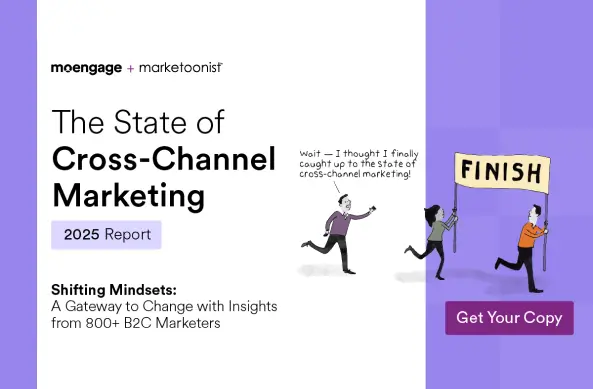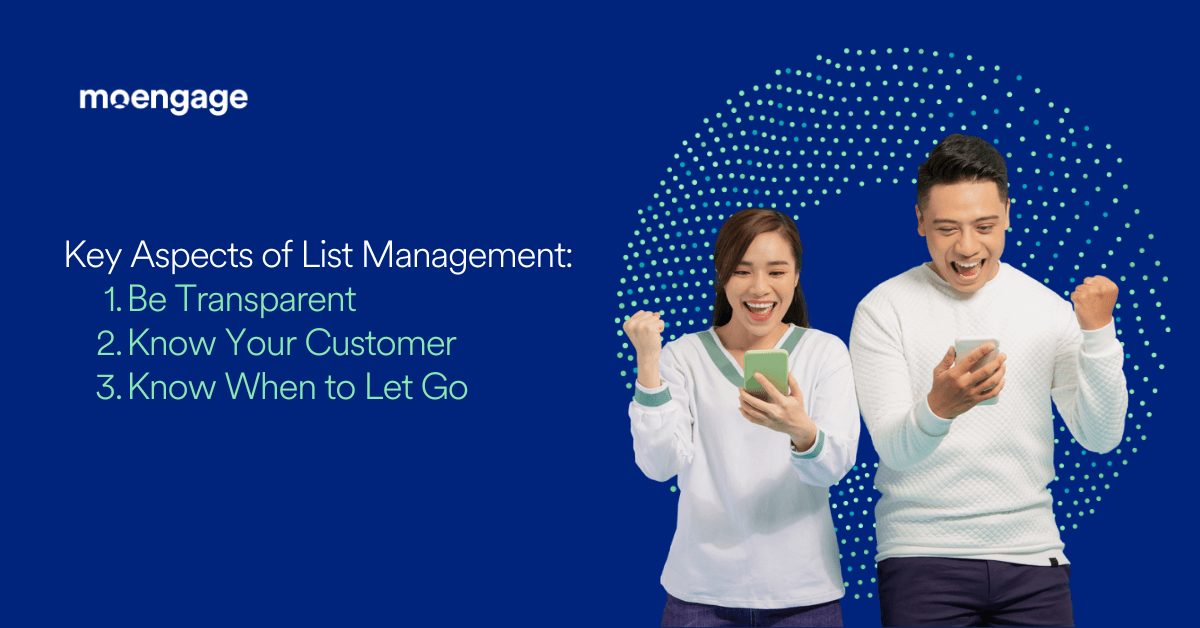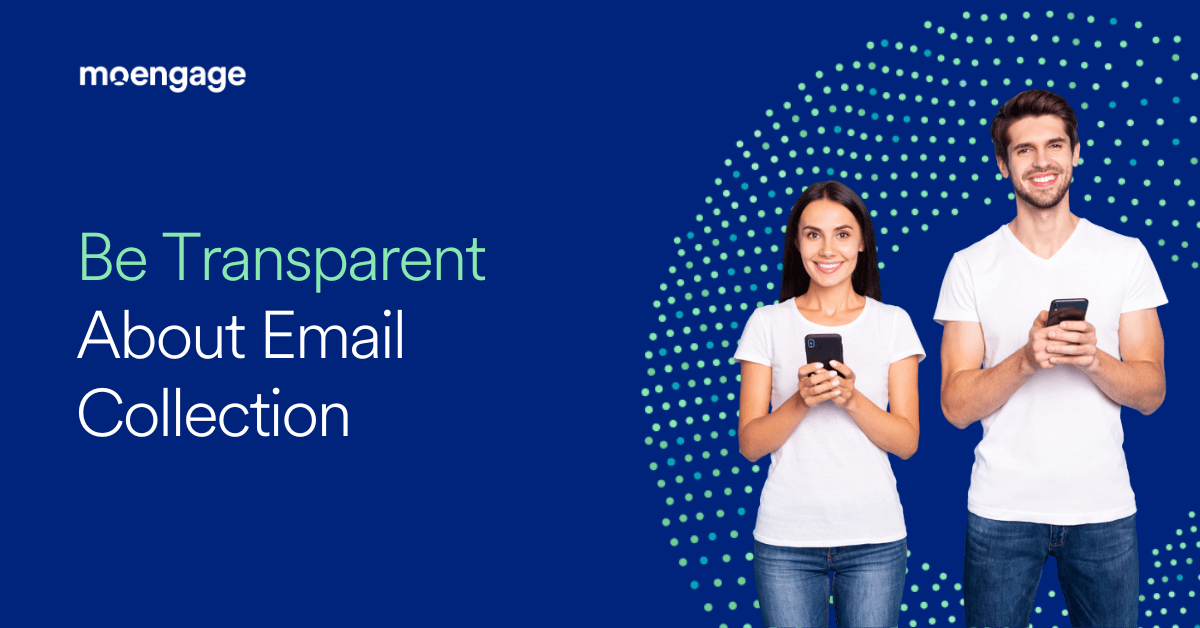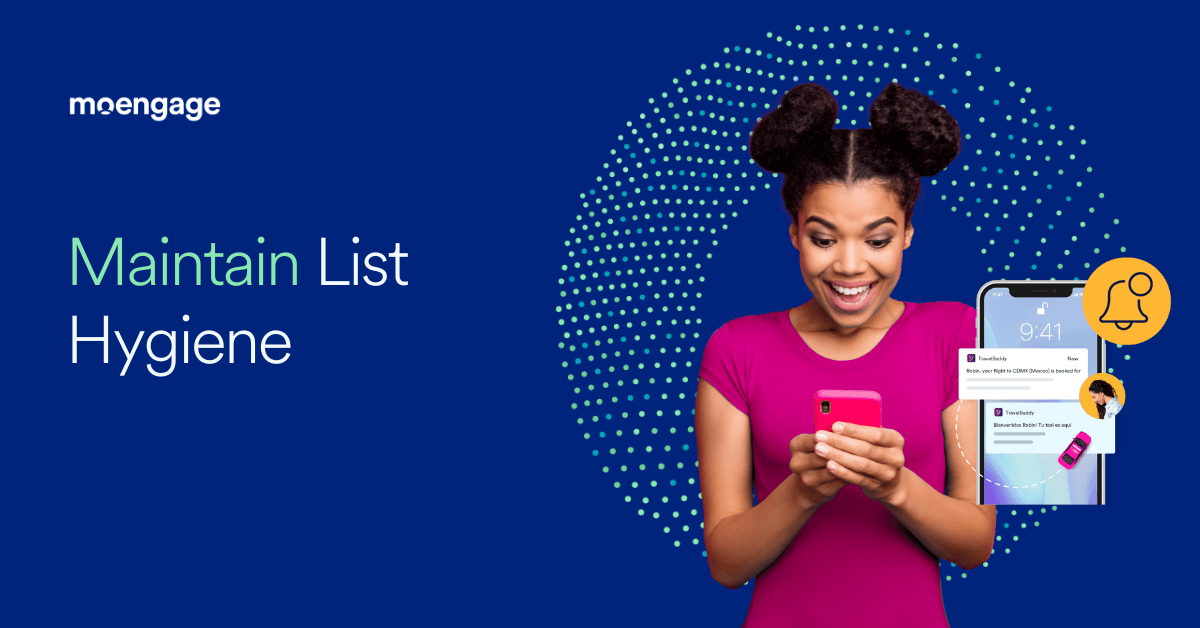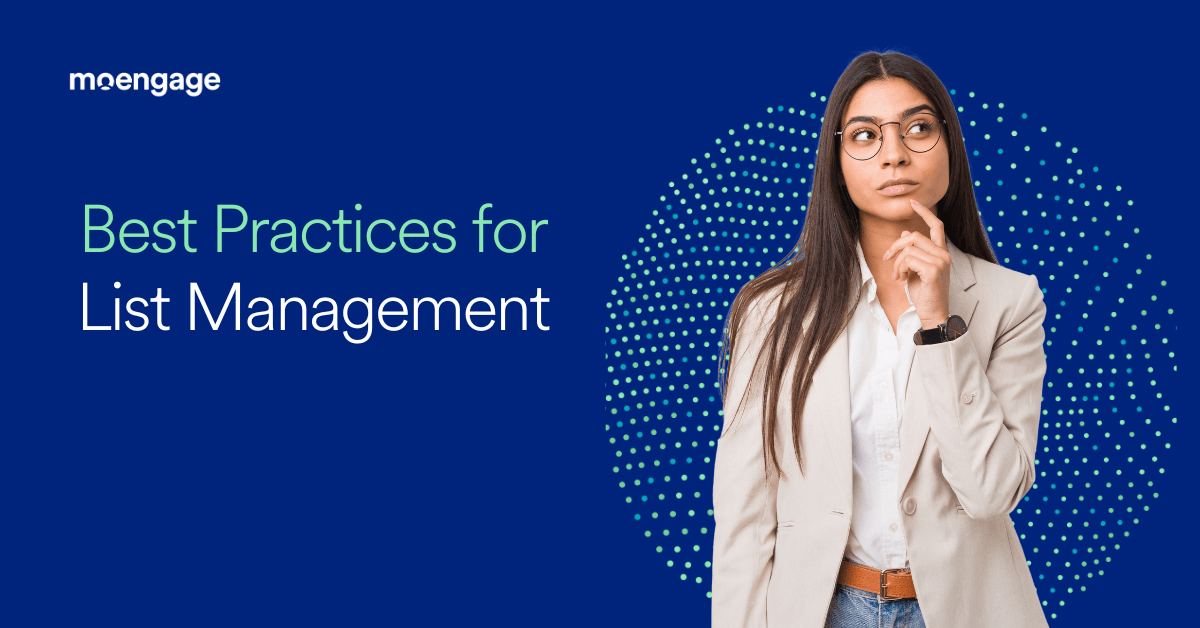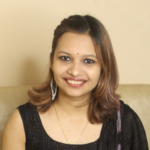Effective Email List Management Strategies for Marketing Success

Reading Time: 7 minutes
List management is a key pillar of your email marketing strategy because it can influence your sender reputation and brand image. Effective email list management ensures that you engage with the right audiences interested in your products or services. It also helps you optimize your email marketing budget by ensuring that you reach customers most likely to respond positively.
From a compliance perspective, list management is essential for global data protection and privacy regulations such as the GDPR or the CAN-SPAM Act in the US.
In this article, we’ll cover the importance of email list management, strategies for building clean email lists, maintaining list hygiene, and best practices such as sunsetting.
Is Email List Management the Same As List Cleaning?
No! List cleaning is a way to scrub out invalid users from your list. Third-party services can clean your list and remove most invalid addresses.
Email list management, however, is more than just scrubbing your list. It encompasses the entire practice of managing an email list, from acquiring email addresses to dealing with customers who have become non-responsive.
Why Email List Management Matters
Email list management can help you outperform your competitors by generating an outstanding ROI on your email marketing campaigns.
Moreover, managing your email list can help you:
- Better understand your audience, including the key subscribers who bring in the most value for your business.
- Ensure your emails land in the inbox instead of the recipient’s spam folder.
- Keep your list healthy, steering clear of fake and unwanted email addresses like spam traps.
- Lower your email marketing costs, as most email providers’ fees depend on the size of your email list.
Key Aspects of Email List Management
Here’s a quick checklist to help you get the email list management basics right.
1. Be Transparent
- Use clean and clear list collection methods
- Comply with regional and global data collection and privacy laws
- Set the right expectations from your customers
2. Know Your Customer
- Who is “safe” to reach based on your mailing requirements without hurting your reputation and email deliverability?
- Whom can you reach infrequently so that they remain your customer without being annoyed and opting out?
Whom should you engage only during peak seasonal mailings or major sale events to drive some conversions from them without affecting your deliverability?
3. Know When to Let Go
An extended period of non-response is as good (or bad) as a negative response. It will hurt your email deliverability in the long run.
Now, let’s dive into each of these in detail.
Email List Collection
Each country has established stringent local laws regarding collecting and handling sensitive customer data. Before you start with email list management, ensure that your data collection methods are clean and ethical.
The goal of collecting email addresses to build your email list is to engage with customers in a meaningful manner. If your emails aren’t perceived as “relevant” or meaningful by your recipients, you risk getting marked as spam or sent to the trash folder. When this happens, your domain and sender reputation take a direct hit. It also gets difficult to establish affinity towards your brand while keeping email engagement metrics low. Needless to say, such a list will not generate substantial revenue.
Here’s how you can ensure that your email list collection is clean and ethical:
- Let your customers choose if they want to receive your marketing emails
- Do not auto-check “Subscribe to marketing emails” while collecting email addresses
- Try sending a double-opt-in campaign to be sure of their consent
- Tell customers upfront what you would do with their email address
- Be clear about how often customers will be hearing from you
- Describe what kind of emails you plan on sending
- Outline your data protection and privacy practices
- Explain how you store your email data, the time frame for storage, and whether customers can request data deletion at any time
- Mention if your customer’s data will be shared with other brands
- Never purchase an email list
- Purchased email lists only create deliverability and domain reputation issues
| 💡MoEngage Pro Tip 💡
When you’re running brand awareness campaigns, you should direct customers to your website before encouraging direct sign-ups. This double opt-in ensures that customers know what they’re signing up for. It might seem like an additional step that creates friction and could result in losing invaluable customers, but the benefits of consensual email collection far outweigh the costs. |
Maintaining List Hygiene
Once you’ve ensured your list collection is clean, the next step is maintaining email list hygiene.
This is important because customers could subscribe to a brand and then quickly lose interest, change priorities, or simply get bored. Marketers need to understand these changing needs and have strategies to address them. Dynamic segments that constantly look at changing customer behavior and patterns (such as engagement history and brand affinity) can help your brand here.
Ideally, for effective email list management, you should organize your customer database into the following:
1. New Customers:
An onboarding flow is a great way to acquaint these customers with your brand and send patterns.
2. Active/Inactive customers:
- “Active” here means being active with your emails and brand.
- Your sending patterns should address customers’ increasing or waning interest levels.
- Remember not to send generic emails to customers whose interests are waning. Otherwise, they will soon opt out.
3. Seasonal Customers:
You only meet some friends once a year, during holidays, and never hear from them throughout the year. Some customers treat their brand relationships the same way. Identify those and cater to them accordingly.
4. Suppression:
- Some customers express disinterest explicitly through unsubscribes and spam complaints. They should immediately be suppressed from all non-transactional emails.
- It’s also a compliance requirement that these be suppressed within two days.
- Hard bounces, i.e., email addresses that don’t exist, should be suppressed instantly.
- While these are only temporary failures, consistent soft bounces should also be suppressed. For example, if a customer has a full mailbox, you can’t email them every week and wait for them to clean their mailbox, receive it, and be interested in it. These are very unlikely scenarios and aren’t worth dipping your delivery rates every day.
Next, let’s take a look at email sunsetting.
What is Sunsetting in Email Marketing and Why Is It Important?
Sunsetting is a strategic activity that lets you identify inactive email recipients and stop emailing them. Sunsetting helps you keep your email list clean, while also ensuring that you get higher ROI from emailing engaged customers. Moreover, if you don’t practice sunsetting, your customer’s mailbox or ESP will automatically disable your brand’s email address.
Email List Management Best Practices
To help you get started, we’ve listed some best practices for email list management:
Data Collection
1. Collect email IDs only from customers who have explicitly consented to do so.
You can do this via:
- Double opt-ins: When a customer signs up with your brand, send them an email and ask them to click on the verification link before you start emailing them
- Single opt-ins with a captcha: Captchas are useful because they prevent bot signups. You can either ask customers to enter a captcha or re-enter their email address (to avoid typos). You can also integrate with a real-time list validation service to verify emails at the sign-up stage.
2. Be transparent and set the right expectations with your customers.
- Mention why you are collecting their email addresses and other data
- Cover what you intend to do with the collected data
- Mention if the data be shared with other brands
- List out the types of communications you plan on sending and how frequently you will engage with them
3. Don’t auto-check the “Send me promotions” checkbox.
Don’t automatically check the “send me marketing/promotional/newsletters/etc.” checkbox when customers need to input an email address for any transaction.
4. Do not purchase lists.
Don’t buy contact lists or scrape email addresses — i.e., do not send emails to consumers who have not explicitly consented to receive them.
5. Always be compliant
You must comply with the data collection, protection, and privacy laws in your country:
- US Digital Service Act (DSA) & Digital Market Act (DMA) from 2024
- General Data Protection Regulation (GDPR, May 25, 2018)
- California Consumer Privacy Act (CCPA, January 1, 2020)
- Controlling the Assault of Non-Solicited Pornography And Marketing (CAN-SPAM, 2003)
- Canada’s anti-spam legislation (CASL, 2014)
- Vietnam’s marketing and advertising laws, updated on 15 September 2021
- Australia’s Spam Act 2003
Hygiene in Email List Management
Identify the best time to send emails for each customer or cohort at an individual level and schedule emails accordingly. Tailor your send frequency to customer engagement levels. Here’s a quick example of how this might look:
- Most active: 3-4 emails a week
- Less active: 1 email a week
- Seasonal customers: Once a month
- New customers: As per the onboarding flow
- Inactive customers: Send retargeting emails once a month. Retire if they remain unengaged even after retargeting efforts.
List Suppression
- Hard bounces, unsubscribes (both from in-email unsubscribe and list unsubscribe), and spam complaints should be suppressed immediately.
- MoEngage automatically suppresses BUC (Hard Bounce, Unsubscribe, Complaints) customers from all non-transactional emails.
- If a customer has consistent soft bounces, barring IP/Domains blocks, for more than 30 days, suppress them as well.
Sunsetting
Identify customers who display a continued lack of activity and sunset them.
Use Email List Management and Marketing Software Like MoEngage
In conclusion, effective email list management is crucial for email marketing success. It ensures engagement with the right audience, delivers greater ROI, and ensures compliance with data protection and privacy regulations.
Looking for the best email marketing platform? MoEngage helps you boost your email delivery by 30%, ensuring the emails land straight in the recipient’s inbox. Our deliverability consultants can help you fine-tune your email strategy to achieve 95% inbox placement rates.
Impressed already? Get a demo of MoEngage today.

